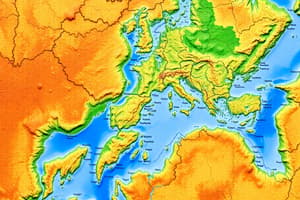Podcast
Questions and Answers
What is the main focus of physical geography?
What is the main focus of physical geography?
- Human activities and cultures
- The Earth's natural processes and features (correct)
- The impact of climate on human societies
- Map-making and geographic data representation
What is the primary purpose of Geographic Information Systems (GIS)?
What is the primary purpose of Geographic Information Systems (GIS)?
- To provide disaster response services
- To facilitate international trade discussions
- To capture, store, analyze, and display spatial data (correct)
- To conduct qualitative research only
Which method focuses on understanding complex social phenomena and cultural perspectives?
Which method focuses on understanding complex social phenomena and cultural perspectives?
- Qualitative research methods (correct)
- Statistical analysis
- Quantitative research methods
- Modeling and simulation
Which sub-branch of human geography examines the distribution of populations?
Which sub-branch of human geography examines the distribution of populations?
What is an important application of geography related to managing urban development sustainably?
What is an important application of geography related to managing urban development sustainably?
What does the term 'region' refer to in geography?
What does the term 'region' refer to in geography?
What does remote sensing primarily involve?
What does remote sensing primarily involve?
What is the primary concern of environmental geography?
What is the primary concern of environmental geography?
Which research method is most effective for analyzing numerical data to reveal spatial trends?
Which research method is most effective for analyzing numerical data to reveal spatial trends?
What does 'absolute location' define?
What does 'absolute location' define?
Flashcards
Geography
Geography
The study of Earth's surface, features, people, and phenomena.
Place
Place
A specific location on Earth with unique features.
Space
Space
The concept of area or extent.
Region
Region
Signup and view all the flashcards
Location
Location
Signup and view all the flashcards
Globalization: definition
Globalization: definition
Signup and view all the flashcards
GIS: function
GIS: function
Signup and view all the flashcards
Remote Sensing: method
Remote Sensing: method
Signup and view all the flashcards
Qualitative Research: approach
Qualitative Research: approach
Signup and view all the flashcards
Urban Planning: goal
Urban Planning: goal
Signup and view all the flashcards
Study Notes
Introduction to Geography
- Geography is the science that studies the Earth's surface, its features, inhabitants, and phenomena. It encompasses both physical and human aspects.
- It investigates spatial patterns and processes, seeking to understand how and why different things are located where they are.
- Geographers explore the relationship between people and their environment, analyzing how human activities affect landscapes and ecosystems, and vice versa.
- Geography involves both qualitative and quantitative methods, combining fieldwork, mapping, and statistical analysis.
Branches of Geography
- Physical Geography: Focuses on the Earth's natural processes and features, such as climate, landforms, hydrology, and biomes.
- Sub-branches include climatology, geomorphology, hydrology, biogeography, and soil geography.
- Human Geography: Examines the spatial distribution of human activities, cultures, and populations.
- Sub-branches include population geography, urban geography, economic geography, cultural geography, political geography, and historical geography.
- Environmental Geography: Studies the relationships between human societies and their natural environments, focusing on how human actions impact the planet, and how environmental factors affect human societies.
- Explores issues like climate change, resource management, pollution, and conservation.
- Cartography: The science of map-making and the visual representation of geographic data.
Key Concepts in Geography
- Place: A specific point on Earth's surface with unique characteristics that distinguish it from other locations.
- Space: The abstract concept of area or extent.
- Location: The position of a place on Earth.
- Absolute location uses coordinates (latitude and longitude).
- Relative location describes a place in relation to other places.
- Region: An area of land with shared characteristics, such as climate, culture, or political systems.
- Formal regions have clearly defined boundaries and shared characteristics (e.g., a country).
- Functional regions are defined by a particular activity or interaction (e.g., a metropolitan area).
- Vernacular regions are defined by perceptions and feelings (e.g., the "South").
- Scale: The ratio of a map's distance to the corresponding distance on Earth. Different scales show different levels of detail.
- Globalization: The increasing interconnectedness and interdependence of countries and cultures through trade, communication, and technology.
- Spatial interaction: The flow of people, goods, ideas, and information between different places.
Tools of Geography
- Geographic Information Systems (GIS): A computer-based system for capturing, storing, analyzing, and displaying spatial data.
- Used to create maps, analyze patterns, and model geographic phenomena.
- Remote Sensing: Acquiring data of Earth's surface from a distance (e.g., using satellites or aircraft).
- Enables monitoring changes in land cover, vegetation, and natural disasters.
- Maps: Visual representations of geographic data, showing locations, features, and patterns.
- Statistical analysis: Used to identify trends and patterns in geographic data.
- Fieldwork: Direct observation and data collection in the field.
Methods and Techniques
- Qualitative research methods: Provide insights into complex social phenomena, cultural perspectives, and local interpretations.
- Quantitative research methods: Used to collect, analyze, and interpret numerical data, allowing for the analysis of spatial patterns and trends.
- Modeling and simulation: Creating visualizations and predictions of geographic processes and phenomena in a digital environment.
Applications of Geography
- Urban planning: Developing strategies for efficient and sustainable urban development.
- Environmental management: Protecting and conserving Earth's resources and ecosystems.
- Resource management: Identifying and utilizing natural resources effectively and sustainably.
- Disaster response and mitigation: Preparing for and responding to natural disasters like floods, earthquakes, and wildfires.
- International relations: Understanding the spatial dimensions of political and economic interactions between nations.
- Tourism and recreation: Planning and managing tourism activities to minimize environmental impacts.
Studying That Suits You
Use AI to generate personalized quizzes and flashcards to suit your learning preferences.




